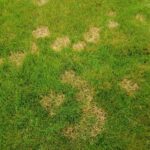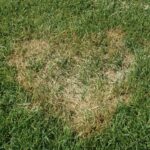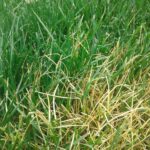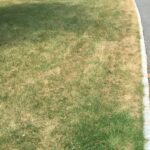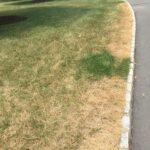Table of Contents
ToggleLast Updated on April 13, 2025
Watering your lawn is one of the best things you can do during the summer months to keep it looking great. Unfortunately, many people don’t know that irrigating incorrectly can have negative effects on your turf’s appearance. Improper watering practices can play a major role when it comes to lawn diseases. This blog discusses proper watering practices to limit disease problems in your lawn.
When visiting a homeowner’s property, I commonly see irrigation systems set to run a watering cycle every day or every other day for twenty minutes. Unfortunately, this watering schedule is not ideal for promoting turf health.
Watering every day or every other day for twenty minutes only keeps the surface of the grass and the top one to two inches of soil wet. This can cause a number of issues. First, when watering every day for a short amount of time the surface of the grass does not get a chance to dry out, which increases the likelihood of getting disease, especially in the summer. It also promotes a shallow root system since the moisture doesn’t penetrate the soil very deep. Turf with shallow roots will not be as healthy or resilient as a plant with a deep, extensive root system. In addition, our service area is predominantly clay-based soil, which holds moisture much longer than other soils. Finally, frequent watering leads to clogged pours and oxygen not being able to get to the root system of the plant, weakening and potentially killing the plant.
How should I run my sprinklers?
We recommend watering infrequently, but for a long duration so the turf and top layer of soil has time to dry out in between watering sessions and help curb disease activity. This also allows the water to penetrate deep into the soil, promoting a deep root system. A good starting point for an irrigation system is twice per week and one hour per zone. This is just a starting point, you’ll need to adjust this for your particular property, especially if your lawn holds moisture in certain areas or has a history of getting disease. You may also need to stop irrigating if we get a lot of rain in a short period of time. One thing to keep in mind during the summer is the longer the grass blades stay wet, the better the chance of getting turf disease.
Almost all the same principles can be applied to homeowners that need to water using a hose-end sprinkler. The biggest difference being the running time. The output of the hose will be much less than an irrigation system which will increase the time you need to water your lawn. The time will most likely be 2-3 hours per area of coverage. Again, check your soil moisture to make sure the water is getting deep enough.
When is the best time of day to run sprinklers?
We often see irrigation systems set to run early in the evening. When it comes to preventing disease, running sprinklers at this time is a bad idea. We want to limit how long the grass blades remain wet. If you start watering your lawn at 6 pm, the turf is going to stay wet through the night until the sun comes up the next day. The grass will be wet for over 12 hours, which is not ideal.
The best time to water is from 12 am to 6 am. The reason for this time frame, is because the lawn gets a natural dew overnight, and there is nothing we can do to stop that. Since the grass is already going to be wet during this time naturally, it’s best to also water at the same time.
Start Watering Before the Lawn Becomes Stressed
Many homeowners wait until the lawn starts to look heat stressed before watering. Unfortunately, this mistake can lead to disease infection. The reason being that heat stressed lawns are more vulnerable to disease outbreak. Just like people, the healthier they are, the more likely they can fight off infection. Start to run your irrigation in late spring before it becomes heat stressed.
Over Watering Turf
This isn’t something I run into too often, but I have seen a few instances where over watering creates large issues. Irrigating turf every day or every other day for 45 minutes to an hour is going to create problems. First your watering bill is going to be through the roof when it doesn’t need to be. The pours at the surface of the soil are never going to dry out and will keep your lawn waterlogged. When this happens, it creates a nice breeding ground for gray leaf spot. This is not a disease you want in your lawn, as it spreads very quick and does a good amount of damage that would require seeding. All the lawn needs is a heavy watering once maybe twice a week depending on weather conditions for 60 to 90 minutes per zone with an irrigation system, and around 2-3 hours with a hose-end sprinkler.
In conclusion
To recap, water on an as needed basis. The three key points you should follow are; avoid watering every day or every other day, water heavily to get the water down at least six inches into the soil and avoid prolonged wetness of the surface by watering at the proper time of day. By following these cultural practices, you will help the turf by limiting the spread of disease. The worst part about lawn disease is you could do everything perfectly and still get disease. Just like people, turf is a living thing and can get sick. If this is the case, there are fungicide treatments that can be applied to prevent and stop the spread of most diseases.
For more information about best watering practices or disease control, feel free to call our office and request a free estimate.


